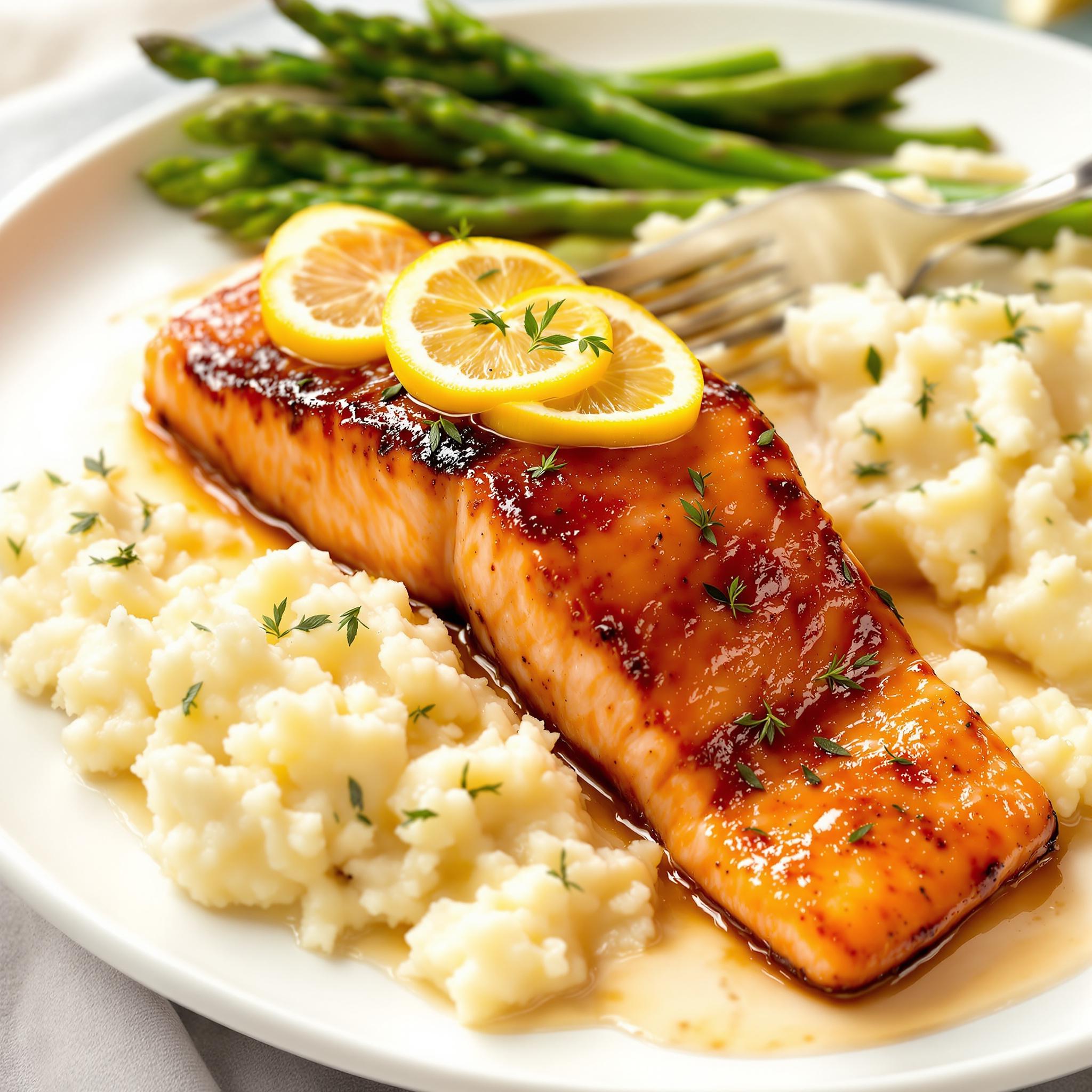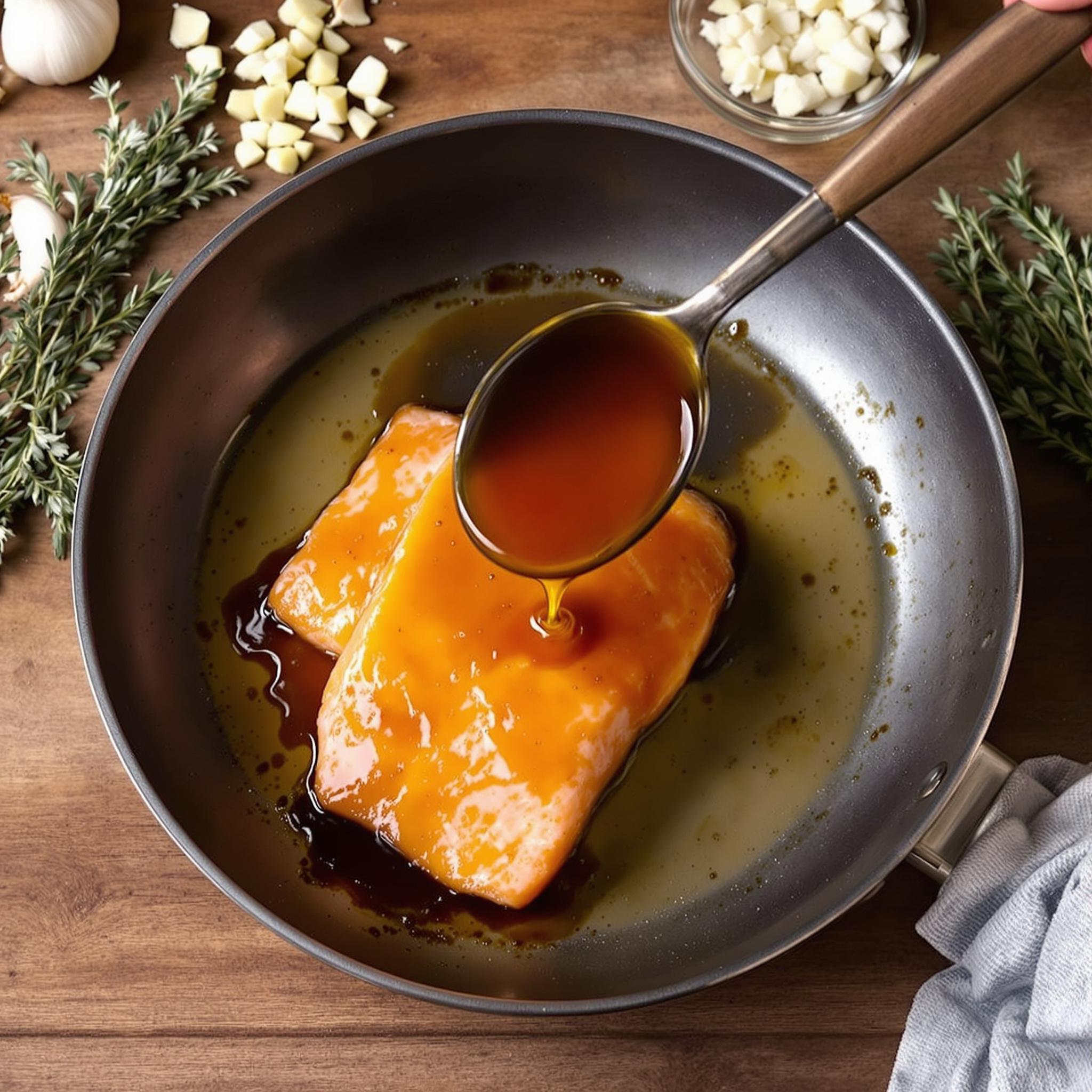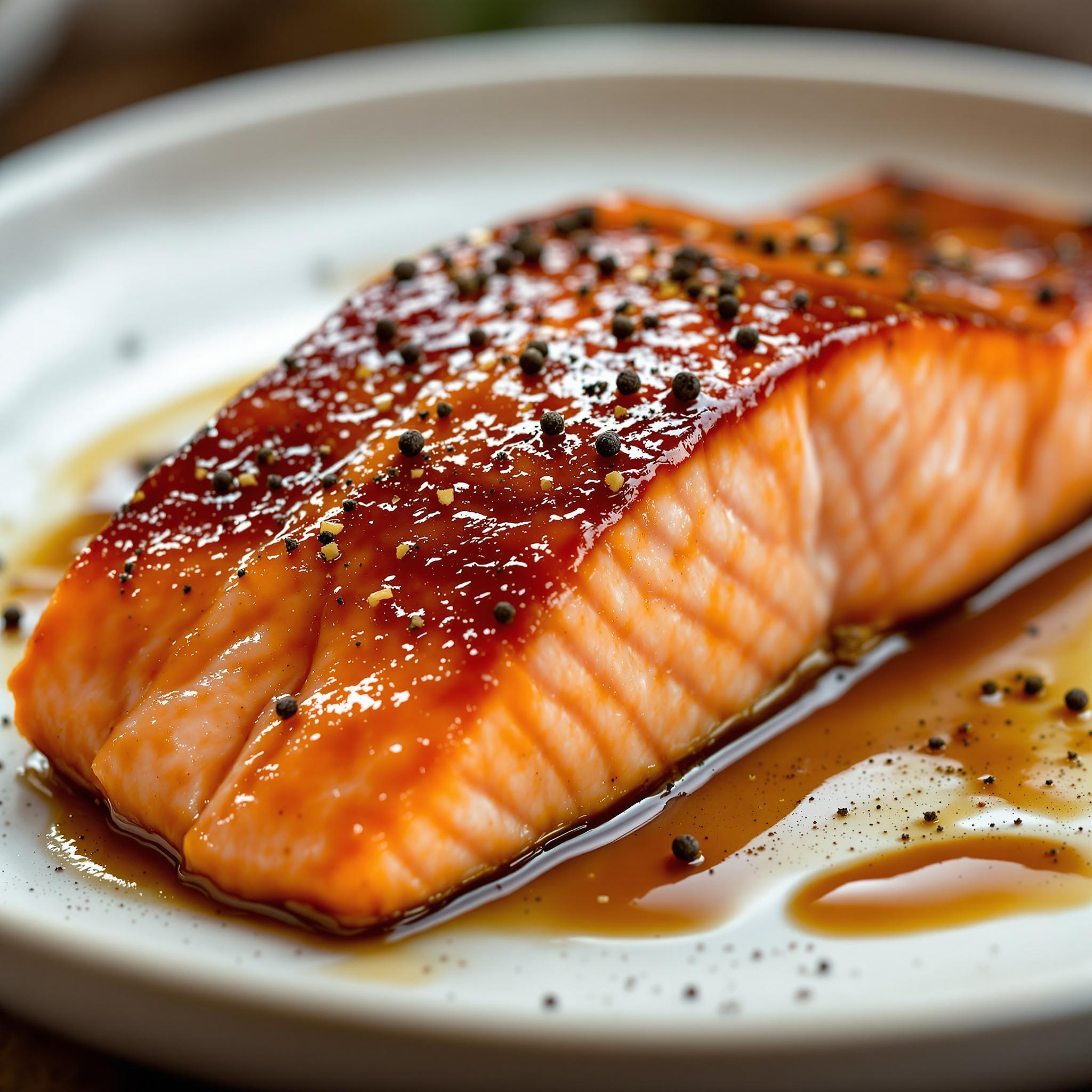
Introduction to Maple Salmon: A Sweet and Savory Delight
There’s something truly magical about the combination of sweet maple syrup and tender, flaky salmon. This Maple Salmon recipe has become one of my all-time favorites because it’s quick, easy, and always impresses. Whether I’m cooking for family dinners or hosting a dinner party, this dish never fails to bring smiles to everyone’s faces. The sticky glaze caramelizes beautifully in the oven, creating a flavor-packed crust that pairs perfectly with the buttery richness of the fish. Trust me, once you try this maple-glazed salmon, it’ll become a staple in your kitchen.
The Origin of Maple Salmon: A Fusion of Flavors
This recipe is inspired by the classic pairing of salmon and maple syrup, a tradition rooted in North American cuisine. Maple syrup, a natural sweetener derived from the sap of maple trees, has been used for centuries in savory dishes. Over time, chefs began experimenting with its versatility, combining it with proteins like salmon to create a balance of sweetness and umami. I first tried making this maple-glazed salmon on a chilly autumn evening when I wanted something comforting yet elegant. Since then, I’ve tweaked the recipe countless times, adding spices and herbs to enhance the flavors while keeping it simple enough for busy weeknights.
Why You’ll Love This Maple Salmon Recipe
What makes this maple salmon dish so irresistible? For starters, it’s incredibly flavorful without being overly complicated. The glaze is made with just a few pantry staples, yet it delivers restaurant-quality results every time. Plus, it’s ready in under 30 minutes, making it perfect for those evenings when you’re short on time but still want to serve something special. Whether you’re a seasoned cook or a beginner, this recipe is foolproof and adaptable to your taste preferences.
Perfect Occasions to Prepare Maple Salmon
This maple-glazed salmon is versatile enough to suit any occasion. Serve it as the star of a holiday feast, alongside roasted vegetables and wild rice. It’s also great for casual weeknight dinners or even date nights at home. If you’re hosting friends, consider preparing individual portions of maple salmon fillets as an appetizer—they’re sure to wow your guests!
Ingredients for Maple Salmon
- 4 salmon fillets (about 6 ounces each)
- 1/4 cup pure maple syrup
- 2 tablespoons soy sauce
- 1 tablespoon olive oil
- 2 cloves garlic, minced
- 1 teaspoon Dijon mustard
- 1/2 teaspoon smoked paprika
- Salt and pepper to taste
- Fresh parsley, chopped (for garnish)
Substitution Options for Flexibility
If you don’t have all the ingredients on hand, no worries! Swap out the soy sauce for tamari if you need a gluten-free option. Honey or brown sugar can replace maple syrup, though the flavor won’t be quite as authentic. Instead of fresh garlic, use 1/2 teaspoon of garlic powder. Feel free to experiment with different seasonings like chili flakes or lemon zest to customize your maple salmon recipe.
Preparation: Step-by-Step Guide
Step 1: Preheat and Prep
Start by preheating your oven to 400°F (200°C). Line a baking sheet with parchment paper or lightly grease it to prevent sticking. Pat the salmon fillets dry with paper towels—this step ensures they sear nicely and develop a golden crust. Season both sides of the fillets with salt and pepper. Pro tip: Removing excess moisture helps the glaze adhere better during cooking.
Step 2: Make the Glaze
In a small bowl, whisk together the maple syrup, soy sauce, olive oil, minced garlic, Dijon mustard, and smoked paprika. The mixture should be smooth and fragrant, with a deep amber color. Taste the glaze and adjust the seasoning if needed; you can add a pinch more paprika for smokiness or a splash of lime juice for brightness. This maple salmon glaze is what transforms ordinary salmon into something extraordinary.
Step 3: Coat and Bake
Place the salmon fillets skin-side down on the prepared baking sheet. Brush the glaze generously over each piece, ensuring they’re fully coated. Pop the tray into the oven and bake for 12–15 minutes, depending on the thickness of the fillets. Keep an eye on them—the edges should caramelize slightly, and the fish should flake easily with a fork. Pro tip: For extra caramelization, broil the salmon for 1–2 minutes at the end of cooking.

Chef’s Tip: Elevate Your Maple Salmon
To take your maple salmon recipe to the next level, sprinkle some sesame seeds over the glazed fillets before baking. They add a delightful crunch and nutty flavor that complements the sweetness of the maple syrup. Another secret? Finish the dish with a squeeze of fresh lemon juice right before serving—it brightens up the entire plate.
Time Breakdown for Maple Salmon
- Prep Time: 10 minutes
- Cooking Time: 15 minutes
- Total Time: 25 minutes
Nutritional Information
Each serving of maple salmon contains approximately 300 calories, with 20g of protein, 15g of fat, and 18g of carbohydrates. It’s rich in omega-3 fatty acids, thanks to the salmon, and provides a balanced mix of nutrients for a wholesome meal.
Extra Information: Fun Fact About Maple Syrup
Did you know that it takes about 40 gallons of maple sap to produce just one gallon of pure maple syrup? That’s why high-quality syrup is such a prized ingredient—it’s literally liquid gold!
Necessary Tools for Preparation
- Baking sheet
- Parchment paper or nonstick spray
- Whisk
- Small mixing bowl
- Brush for glazing
Storage Instructions
Let the maple salmon cool completely before storing it in an airtight container. Refrigerate for up to 3 days. To reheat, place the fillets in a skillet over low heat with a splash of water to keep them moist. Alternatively, microwave them for 30 seconds, checking frequently to avoid overcooking. Freezing isn’t recommended, as the texture of the fish may change upon thawing. However, if you must freeze, wrap the cooked salmon tightly in plastic wrap and consume within a month.
Tips and Tricks for Perfect Maple Salmon
For the crispiest skin, start by searing the salmon in a hot pan before transferring it to the oven. This technique locks in juices and adds another layer of texture. Another trick is to let the glaze reduce slightly on the stovetop before brushing it onto the fish—it thickens and becomes even stickier. Lastly, don’t overcrowd the baking sheet; give each fillet space to breathe for even cooking.

Serving Suggestions
Pair your maple salmon with steamed broccoli and quinoa for a light yet satisfying meal. For a heartier option, serve it alongside roasted sweet potatoes and green beans. Garnish with fresh parsley or dill for a pop of color and freshness.
Healthier Alternatives for Maple Salmon
Here are six ways to make this recipe healthier:
- Low-Sodium Option: Use low-sodium soy sauce to reduce salt intake.
- Gluten-Free Version: Substitute tamari for soy sauce.
- Less Sugar: Reduce the amount of maple syrup and add a bit of balsamic vinegar for tanginess.
- Vegan Twist: Replace salmon with grilled tofu or tempeh for a plant-based alternative.
- Herb Boost: Add fresh herbs like thyme or rosemary to the glaze for added antioxidants.
- Air Fryer Method: Cook the salmon in an air fryer for a lower-fat option.
Common Mistakes to Avoid
Mistake 1: Overcooking the Salmon
Overcooked salmon becomes dry and loses its delicate texture. To avoid this, check for doneness after 12 minutes of baking. The internal temperature should reach 145°F (63°C), and the fish should flake easily with a fork. Pro tip: Remove the salmon from the oven just before it’s fully done—it will continue cooking from residual heat.
Mistake 2: Skipping the Pat-Dry Step
Not drying the salmon properly can lead to soggy skin and uneven caramelization. Always pat the fillets dry with paper towels before seasoning. This simple step makes a world of difference in achieving crispy skin and a beautiful glaze.
Mistake 3: Using Artificial Maple Syrup
Artificial syrups often contain corn syrup and lack the depth of flavor found in pure maple syrup. Stick to the real deal for the best results—it’s worth the investment!
Frequently Asked Questions
Can I Use Frozen Salmon?
Yes, you can use frozen salmon, but make sure to thaw it completely in the refrigerator overnight. Pat it dry before proceeding with the recipe to ensure proper caramelization.
Is Maple Salmon Gluten-Free?
By default, this recipe isn’t gluten-free due to the soy sauce. However, substituting tamari makes it suitable for those avoiding gluten.
How Do I Store Leftovers?
Store leftover maple salmon in an airtight container in the fridge for up to 3 days. Reheat gently to preserve the texture.
Can I Grill the Salmon Instead?
Absolutely! Grill the salmon over medium heat for 6–8 minutes per side, brushing with the glaze during the last few minutes of cooking.
What Sides Go Well With This Dish?
Steamed vegetables, roasted potatoes, and salads pair beautifully with maple salmon. Choose sides that complement the sweetness of the glaze.
Can I Double the Recipe?
Yes, simply double the ingredients and use two baking sheets to avoid overcrowding. Adjust the cooking time slightly if needed.
Does the Skin Need to Stay On?
While the skin helps hold the fillet together, you can remove it before serving if preferred. Just be careful not to tear the flesh while removing it.
Can I Use Other Fish?
Certainly! Try this glaze on cod, trout, or even chicken breasts for a similar effect.
How Do I Know When the Salmon Is Done?
The salmon is done when it flakes easily with a fork and reaches an internal temperature of 145°F (63°C).
Can I Make the Glaze Ahead of Time?
Yes, prepare the glaze up to 2 days in advance and store it in the fridge. Warm it slightly before using to loosen its consistency.
Conclusion
This maple salmon recipe is a true gem in my collection—a harmonious blend of sweet, savory, and smoky flavors that’s quick to prepare and endlessly satisfying. Whether you’re cooking for yourself or entertaining guests, this dish promises to delight. So grab your apron, gather your ingredients, and let’s create something delicious together. Bon appétit!
